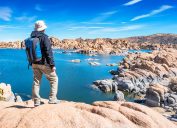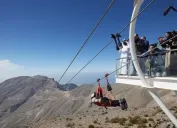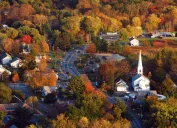The 12 Most Underrated U.S. National Parks You Need to Visit
If you're looking to beat the crowds and explore nature, head to these often overlooked parks.
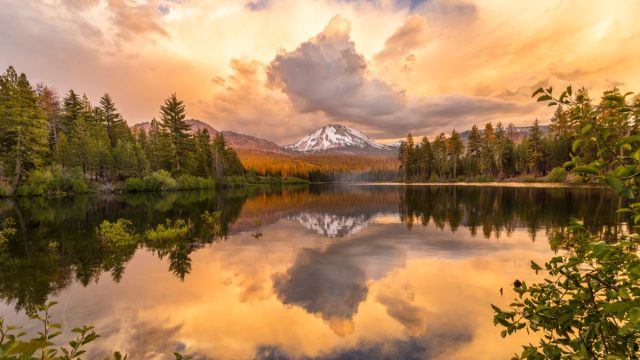
Visiting one of America's national parks is a great way to explore the outdoors and embrace the natural beauty and wildlife around you. These lands are protected for a reason, offering some of the most breathtaking vistas the U.S. has to offer.
Many travelers are eager to get out and explore these parks—and if you've got a list of places you want to see, chances are some of the major players are at the top. In fact, results from a 2020 survey commissioned by the National Park Service (NPS), showed that Yellowstone National Park, Great Smoky Mountains National Park, Grand Canyon National Park, and Yosemite National Park were the spots respondents had most recently been to. All three parks are consistently among the most-visited national parks in the U.S., joined by the likes of Zion, Grand Teton, and Acadia.
But the truth is, there are so many other hidden gems across the U.S. that are ripe for adventure, but don't get their due recognition. So, if you're looking to beat the tourist crowds while getting out in nature, be sure to add these 12 underrated U.S. national parks to your travel itinerary.
READ THIS NEXT: The 7 Newest National Parks You Need to Add to Your Bucket List.
1
Pictured Rocks National Lakeshore (Michigan)

Known for its jaw-dropping multicolored cliffs, secluded white sand beaches, and unusual sandstone formations, this Michigan national park is technically a lakeshore, which you can explore on foot via hiking loops, a boat cruise, or a guided kayak tour.
"There really is something for everyone—families can enjoy the many beaches and easy walks to waterfalls, while couples and solo travelers can get lost in the beauty on a trail or in a kayak," says Rebecca Gade Sawicki, founder of the vegan travel blog Veggies Abroad. "While summer is an optimal time to visit, in the winter, some of the waterfalls turn into spectacular ice caves that visitors can safely explore."
Don't miss the Twelvemile Beach trail, which winds through a breathtaking white birch forest—and definitely check out the shipwreck remnants left on the shoreline near Au Sable Point's 19th-century lighthouse.
2
Haleakala National Park (Hawaii)
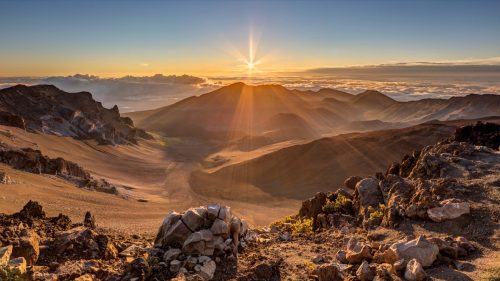
For many travelers, a trip to Hawaii is a bucket list mainstay. But if you plan to visit anytime soon, visiting Haleakala National Park is non-negotiable.
"Standing majestically over 'The Valley Isle' of Maui, the majestic Haleakala volcano is as iconic and culturally important as it is beautiful," Sophie Clapton, travel blogger for We Dream of Travel, tells Best Life.
This Hawaiian park might not get as much attention simply because it's not part of the contiguous U.S., but according to Clapton, it's not a spot you want to miss.
"Haleakala National Park is most known for the sunrise tours and downhill bicycle adventures, but the park holds a wealth of additional features and destinations that most never discover," Clapton says. "These include the Seven Sacred Pools of O'heo, a bamboo forest, and several waterfall trails, to name a few."
Haleakala also has "unique and diverse ecosystems," she shares, truly setting it apart from even the most iconic national parks.
READ THIS NEXT: The 10 Most Naturally Beautiful States in the U.S., New Data Shows.
3
Guadalupe Mountains National Park (Texas)
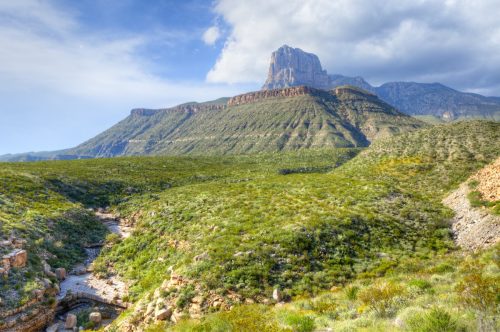
Also on the list of underrated spots is a hidden gem in the Lone Star State.
"Guadalupe Mountains National Park is a hikers paradise in remote Western Texas—and home to the tallest mountain in the state … yet most people have never heard of it!" Adam Marland, travel photographer and blogger for We Dream of Travel, says.
Does the park's name rings a bell? You may have traveled through it without even realizing. "The majority of people who 'visit' the park do so accidentally as they drive the scenic byway from El Paso to Carlsbad," Marland explains. "Those who visit with intention, however, will discover some of the finest desert hiking in the South."
According to the official website for the park, there are over 80 miles of hiking trails at this often overlooked park, with hikes ranging from standard nature walks to challenging all-day hikes that take you to the "Top of Texas." And while you're walking, there's no shortage of sights to see and wildlife to admire.
"Guadalupe Mountains National Park is a place of great desert beauty with a surprisingly diverse natural world to explore for those who know where to look," Marland adds. "Numerous species of cactus, thriving wildlife, impossibly-dark night skies, and imposing mountain peaks are just some of the reasons those who visit this remote and underrated park fall in love with it."
4
Great Sand Dunes National Park and Preserve (Colorado)
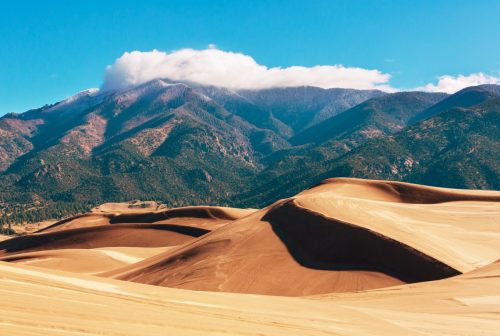
Picture an epic, 30-square-mile sandbox with massive mounds to climb—that's pretty much this Colorado park in a nutshell.
"Flanked by rugged mountain peaks to the east, the park offers the unique experience of climbing up the massive sand dunes as well as more traditional hiking options in the surrounding mountains," says Chris Heckmann, creator of the travel blog Around The World With Me. "Hiking up sand dunes is incredibly hard work, but if you can make it to some of the higher dunes, you'll be rewarded with some awesome views."
If you're particularly ambitious, try hiking the tallest summit, which reaches a whopping 750 feet.
"After sandboarding and sledding down some of the tallest dunes in North America, the kids can cool off in Medrano Creek," says Elise Armitage, writer and founder behind travel and lifestyle blog What The Fab. "The park is a great spot for camping in the summer as the temperatures cool off at night."
Pro tip: If you can, Shaun Hammond, owner and author of the travel blog The Traveling Drifter, recommends sticking around for the awe-inspiring sunsets with shadowy mountain ranges in the distance.
READ THIS NEXT: The 8 Best Off-The-Radar Destinations in the U.S. That Need to Be on Your Bucket List.
5
Theodore Roosevelt National Park (North Dakota)
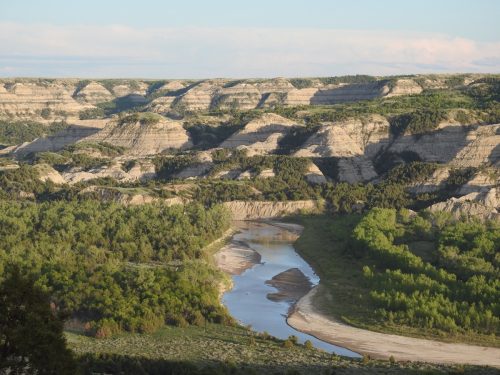
You'd be hard-pressed to find a more family-friendly park than Theodore Roosevelt National Park, says Kristin Secor, owner and author of the travel blog World on Wheels.
"This park is often overlooked by its neighbors in South Dakota and even in Wyoming," Secor tells Best Life. "What's special about it is the cannonball formations found in the northern unit. These formations are made when mineral water seeps down into the buttes and deposits the minerals in gaps in the sediment. The minerals and sediments combine and form a core, which then creates a cannonball appearance. As the buttes erode, these cannonballs stay intact and become visible to visitors."
The park has two sections: the northern and southern units. According to Secor, the southern unit gets a lot more foot traffic, but both are worth a visit to view the gorgeous Badlands buttes.
"Another special thing about the Theodore Roosevelt National Park is the wildlife," adds Secor. "You can find bison, wild mustangs, big horn sheep, and prairie dogs within the park. We were lucky enough to see all of these incredible animals, with the highlight being the wild horses."
6
Lassen Volcanic National Park (California)
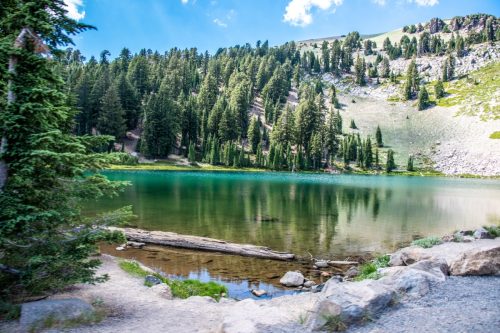
Jennie Flaming, chief adventure officer for Ordinary Adventures, calls this Northern California park a "mini Yellowstone, but even cooler."
"It boasts bubbling mud pots, hot springs, and vibrant blue lakes, but unlike Yellowstone, you won't have to fight the crowds to see them in all their glory," adds Megan Jones, founder of the travel blog Traveller's Elixir.
The trails are pretty manageable, no matter how much hiking experience you have, according to Flaming.
Jones notes that Lassen Volcanic National Park's tallest mountain, Lassen Peak, is an active volcano. So, in theory, it could erupt at any moment—although the last eruption was in 1917.
"You can actually hike up to the top of the peak where you'll be rewarded with some pretty impressive views of the surrounding wilderness," Jones adds. Her favorite spot in the park? The "Devastated Area," where you can scope out massive lava rocks that were left from the volcano's last eruption.
Anu Agarwal, owner and author of Destination Checkoff, also recommends checking out Bumpass Hell trail, which recently added a boardwalk to see the geothermal activity up close, and the subway lava tube at the end of the park.
Just one note: According to Agarwal, you should plan a visit to Lassen Volcanic National Park between June and October, as road access is limited during the snowy season (November to May).
READ THIS NEXT: The 10 Best Weekend Trips You Need to Take This Year.
7
North Cascades National Park (Washington)

North Cascades National Park may be one of the least-visited national parks, but that's just part of the appeal: no long lines, and plenty of peace and quiet. It's also a pet-friendly park, so feel free to bring along your furry companion.
According to Bryn Culbert, budget travel expert at Wanderu, a Wanderu study revealed that this park is tagged with the most Instagram posts relative to its number of visitors. It's easy to see why it's so "Instagrammable"—the picturesque mountain vistas, turquoise alpine lakes, snowy mountains, and breathtaking waterfalls are just a few highlights.
"It is also quite undeveloped, so there are few roads or other structures within the park, allowing you to ditch the crowds and truly disconnect and embrace nature with your loved ones," says Luisa Favaretto, founder and editor of Strategistico.
Axel Hernborg, CEO at Tripplo, notes that there is no entry fee, either. "If you're fond of camping, you won't be disappointed," he says. "What's more, you don't have to hike too much to enjoy a serene view, you're surrounded by it. But if you do like hiking, you can even walk at night in the garden with light-up water features."
According to Favaretto, this park—which is less than a three-hour drive from Seattle—also happens to contain the largest system of glaciers in the contiguous U.S.
"You won't be able to find views with all of these natural elements anywhere else in America," she explains. "The famous Pacific Crest Trail also cuts through the park, so it is a great place for solo hikers to connect with some like-minded folks during their journey as well."
8
Katmai National Park (Alaska)
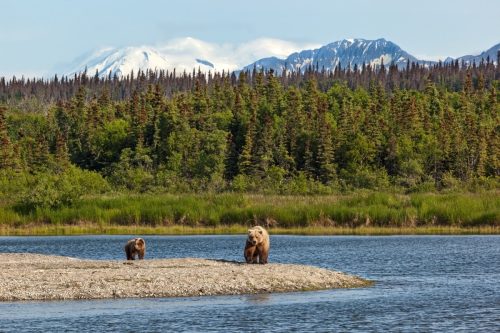
There are no roads leading into this park—so, to get there, you'll need to fly into a nearby Alaska town, and then rent a floatplane to get there. But, according to Jenny Ly, travel blogger at Go Wanderly, it's well worth the extensive trek.
"Don't forget your Sonik fishing gear when visiting Katmai because, in addition to viewing brown bears at Brooks Falls, which are among the biggest in the world due to the plentiful salmon, these activities include excellent kayaking, canoeing, wilderness camping, hiking, and fishing," says Ly.
READ THIS NEXT: The 10 Best 3-Day Weekend Trips in the U.S.
9
Congaree National Park (South Carolina)
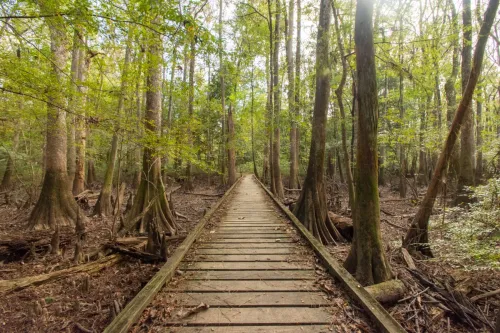
According to Culbert, Congaree National Park is a "little marshy wonderland" that offers perfect for a getaway vacay. Even better, it's a well-kept secret: Many people who live on the East Coast haven't even heard of it.
"The park comprises a huge old-growth bottomland hardwood forest, which is like a swamp, but technically a floodplain, and it's home to one of the highest tree canopies in the world," Culbert says.
Families of all sizes and activity levels can enjoy a short walk on the park's accessible Boardwalk Trail and spot wildlife on the rougher Oak Ridge Trail. Culbert recommends renting a canoe to traverse the Cedar Creek Canoe Trail and try to spot deer, river otters, turtles, and even alligators.
Congaree, which is situated outside of Columbia, South Carolina, also has no entrance fee.
"It's a great place to stretch your legs, rest, and relax on a travel day through the Southeast," says Kimberly Button, creator and author at Wanderful World of Travel. "Though it's not as big and doesn't offer as many trails, there is a unique charm to this location. The 2.4-mile main loop trail at the visitor center is an elevated boardwalk, making it accessible to everyone and allowing them to get out in nature."
Rest assured that Congaree is great for kids and families, too. According to Button, the paved loop trail is easy for everyone to walk and run on without being too challenging.
10
Channel Islands National Park (California)
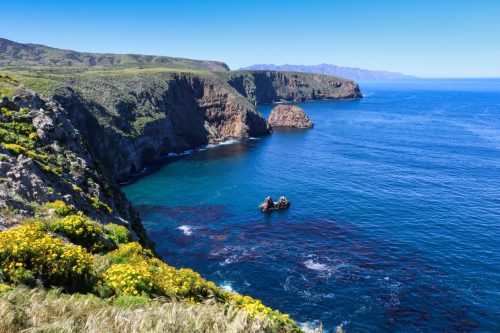
Getting to this coastal California park is a little more complicated than some other parks (except maybe Katmai). While the mainland visitor centers are accessible by car, you'll have to take a boat to the islands. That said, Hanna Ashcraft, founder of the travel blog Moderately Adventurous, says the cruise over is all part of the fun. If you're lucky, you'll even spot some dolphins, whales, sea lions, and sea birds along the journey.
Eva Keller, a co-founder of the travel blog Discovering Hidden Gems, notes that multiple charter boat go out to all four of the park's main islands every day, coming from Ventura and Oxnard—season and weather depending. While each island offers something special, the smallest, Anacapa Island, features a picturesque lighthouse and is a famous nesting site for the Western gull.
"Watch the silly bird antics as you hike to Inspiration Point for a breathtaking view of jagged rocks and the other islands in a row," says Ashcraft.
Santa Cruz Island, the largest, offers longer hikes to beautiful vistas like Potato Harbor, and kayaking tours to explore the sea caves. Santa Rosa Island, which is a little further away, is known for its grove of Torrey pine trees and long sandy beaches.
And finally, Ashcraft says San Miguel Island is best for adventurers who don't mind a long boat ride and want to see sea lions basking on the sandy beach. The best part? If you want to see it all, you can camp overnight on any of the islands.
For more travel advice delivered straight to your inbox, sign up for our daily newsletter.
11
Petrified Forest National Park (Arizona)
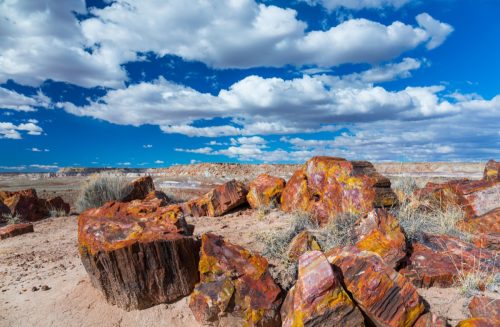
Jessica Schmit, the founder of Uprooted Traveler, has been to 40 national parks—but this one, which is located in Arizona, stands out in her memory. And that's no surprise: True to its name, the park contains one of the world's largest and most colorful concentrations of petrified wood. These mineralized versions of trees date back hundreds of millions of years—before dinosaurs even roamed the earth.
"The park offers points of interest for all kinds of visitors, including hikes and backpacking through incredibly colorful badlands and petroglyphs from ancient Indigenous people," says Schmit. "Even better, the park has a small footprint, so it's easy to see the main highlights of the park in just a day."
While there, check out the Rainbow Forest Museum, which offers paleontology exhibits and many trail access points. If that doesn't strike your fancy, Schmit says there's truly "something for everyone" at Petrified Forest National Park.
"For the history buffs, the park offers a fascinating glimpse into the lives of the Pueblo people, who lived on this land in the 1300s, and it's the only U.S. national park to include a portion of the historic Route 66. More into geology? The park is littered with countless pieces of colorful crystallized wood, fossilized millions of years ago," she explains.
12
Hot Springs National Park (Arkansas)
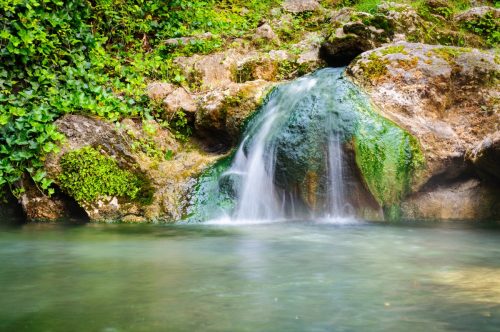
According to Favaretto, Hot Springs National Park is the second smallest national park in the U.S. But that's actually an advantage: You can see all that the park has to offer in one afternoon.
"Hot Springs National Park offers the ideal setting for couples to relax in," says Favaretto. "It features naturally occurring thermal baths where visitors can soak and rejuvenate themselves. This bathing ritual is the perfect experience to share with your partner, where you can reconnect with nature together and enjoy the healing powers of the springs."
The park also features plenty of excellent hiking trails suitable for all levels, which provide scenic views of the vibrant seasonal foliage and downtown Hot Springs.
